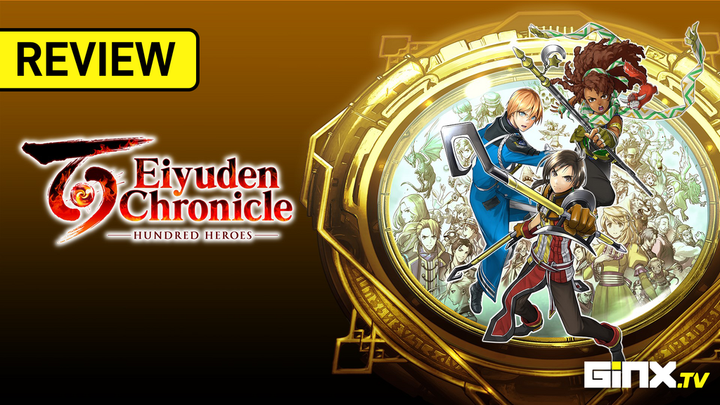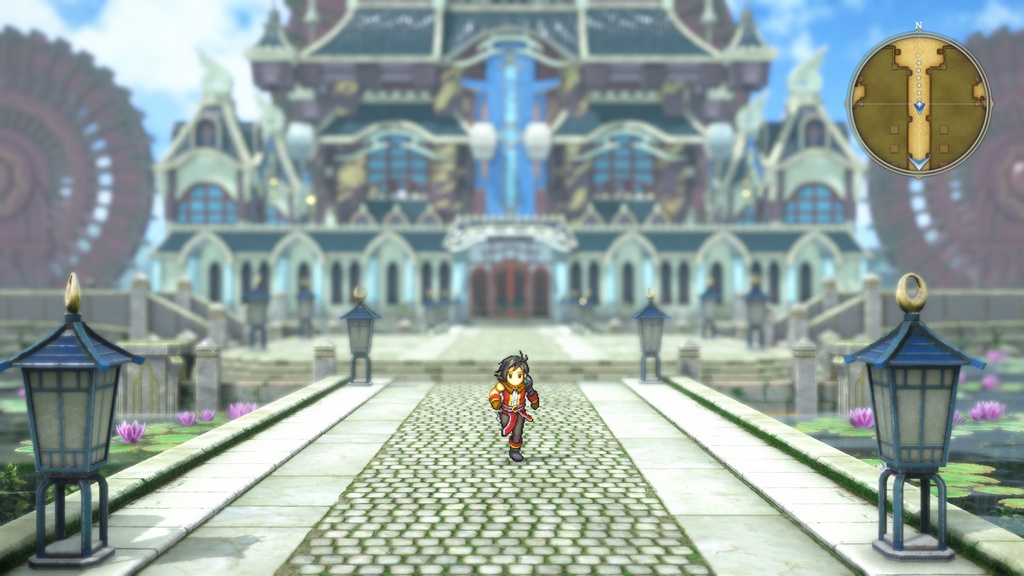Eiyuden Chronicle: Hundred Heroes offers players a unique concept: what if nearly every character you meet on your adventure can be added to your party, fully voice acted and with their own skills and style to utilize in battle. It’s this concept that helped the title become one of the highest funded Kickstarter games in history and, save for a few shortcomings, it delivers on its promise. Directed and produced by the late Yoshitaka Murayama, creator of Suikoden, Hundred Heroes plays like a timeless classic. Full to the brim of JRPG tropes, it builds on the charm established in its prequel, Eiyuden Chronicle: Rising, only this time with more abilities, minigames, storylines and, of course, more characters.
Raising An Army

Combat
Eiyuden Chronicle: Hundred Heroes utilizes turn-based combat. For the majority of the game, you’ll be operating a party of six which, typically, you get to choose the make-up of. In battle, you’ll cycle through your party, choosing which attacks to use on which opponent. After which, the turn will play out. Characters often attack immediately after each other, meaning turns play out fast and you’ll want to pay attention.
Be mindful of the turn order too, displayed at the top. It shows who attacks in which order and, if you're smart about it, you can prevent certain enemies in the chain from getting a hit in.
It's all a little chaotic to begin with, and seeks to make a point of proving that turn-based doesn't necessarily mean slow-paced. But, after a few encounters, it starts to make sense. However, you'll need to take a moment to get acquainted with each party member's specialties to be truly effective. On top of basic attacks, some characters will have access to magic, either offensive, defensive, or healing spells. As you progress and level your characters up, more will have the capacity to use magic. Some party members might also have a connection with another, allowing them to perform strong combined hero attacks. Whether you’re fighting basic enemies or deadly bosses, you’ll have a lot at your disposal when it comes to taking them down.
Characters

Hundred Heroes boasts an ambitious premise within its own title, but it does indeed have over a hundred heroes. It has a core group of main characters that are our main vessels for the game’s story. Nowa is our main protagonist, a young boy from a nearby village who enlists with The Watch and is tasked with recruiting companions to the Alliance. It’s through Nowa that we forge our connections with the rest of the cast. Other storylines include Seign, a young lieutenant of the Empire who has his family name hanging over his head, and Marisa who acts as Guardian of the mystical Runebarrows. Outside of the mainstays, there are plenty of other characters you’ll recruit, utilize, and fight alongside. While the breadth of characters sounds unique on paper, it comes with its pros and cons.
The obvious angle here is that it affords players a great level of customization when it comes to the active party. Each available party member has their own specialties determined by the Runes they carry (which determine the skill or magic ability they have at their disposal). While these can be switched out and customized, during the early game you won’t have a lot of options to choose from outside of a character’s default abilities. You can choose where to place each character on the battlefield, either at the front or the rear.

Short-ranged fighters are best suited to front positions, long-ranged to the back, with medium-ranged fighters being the most flexible. There’s also a slot for Support characters, who provide certain buffs when accompanying the party, though they’ll have no in-battle use. Lastly, there are slots for Attendants. These can be characters that are locked to the party in a specific circumstance, but that you might not want to have doing the fighting. It’s a great way to ensure that you nearly always have control over your party.
The amount of possible party members does also make it tricky to determine who you should bring along with you on each trip, though you can usually succeed with any make-up so long as you’ve put in the time to level the characters. Similarly, swapping equipment and accessories between active and non-active party members is a chore. Though it can be done somewhat more easily once you unlock the main HQ by speaking to the attendant at the Item Warehouse. But it quickly gets to the stage where there are so many characters to adjust that it'll still take you a good few minutes to optimize each one.

You will inevitably gravitate to some favorites, be it for their style or their abilities, and make an effort to have them in your party as much as possible. With Hundred Heroes’ expansive cast, it’s nearly impossible not to like at least a handful of characters. Sadly, with the vast majority being optional party members, it means they don't tend to play a significant role in the story. You won't learn much about them outside of their initial recruitment, or form much connection, though they may say a generic line or two during story beats.
While this might put you off going out of your way to recruit more members to your team, know that not everyone you recruit will be an active party member. After you unlock the HQ, you'll begin meeting characters that will take up other roles around HQ. These characters will offer services, such as running shops or gathering materials over time. For the most part, finding these additional characters is optional, but they provide great benefit to your HQ and will allow you to expand your base.
Build Back Better

An aspect I found surprisingly satisfying is the town building mechanic. A few hours into the story, Nowa has the duty of leading the resistance bestowed upon him, and that also comes with the responsibility of rebuilding the base of operations. To do so, you’ll need a variety of resources, from money to materials to people. Perhaps its biggest comparison in this department is with Ni No Kuni 2, where you’ll be generating resources and cash the more you recruit people and unlock specific buildings. You’ll get to see the HQ flourish into a fully functional town, all of which better serves you on your adventure.
It feels like you’re making visible progression, and helps to break up the linearity of moving through the main story. You can visibly see how far you’ve come thanks to the stores you’ve opened, the characters that begin to inhabit the HQ, and more. It builds on the town building from the prequel, Eiyuden Chronicle: Rising, and offers even more for players to construct.
A Resistance With Style

Like all good RPGs, Hundred Heroes features a delightful soundtrack that enhances your adventure. From atmospheric tones in the depths of the Runebarrows, to a rousing track that threads through every battle. Accompanying the music is the game’s 2.5D style, adopting the trend seen in other modern JRPG classics such as Octopath Traveller or the recent Second Story R. Though Hundred Heroes might not be as overtly stylized as its cohorts, its vibrancy and character art, across all 100+ heroes, makes it a standout.
Coupled with this are its enemy designs, which excel where plenty of titles stumble. There’s great variety to the creatures you’ll fight throughout your adventure, across both boss battles and general enemies. Larger encounters often feature “gimmicks” that your party will need to make use of to gain the upper hand against powerful foes. Don’t mistake that for an easy route, however, as you’ll still need to be strategic with your attacks to avoid a full party wipe.

A deeply enjoyable classic that grows on you the more you play. While it struggles with a slow start, Eiyuden Chronicle: Hundred Heroes begins to open up to its full potential once you unlock the HQ and begin rallying your troops.
Hundred Heroes’ only main downside is the lack of depth given to its huge cast of characters. While you’ll get quickly acquainted with the “main” heroes, some of the recruitable party members are never really given their chance to shine, no matter how interesting they seem when you first meet them. While this might have been solved with a more condensed cast, it would deny Eiyuden Chronicle: Hundred Heroes its unique charm.

 No ads, our video library,
No ads, our video library,


